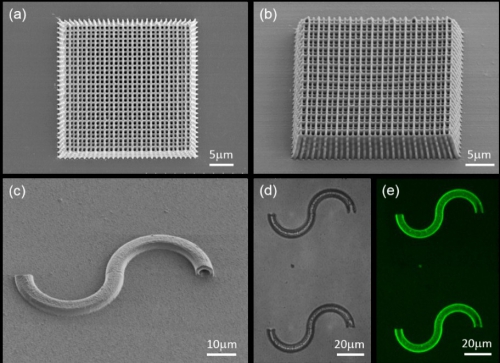Hydrogels are polymer network chains with excellent biocompatibility and high water content ability like extracellular matrix. Bioinspired three-dimensional (3D) hydrogels with precise configuration have been widely employed to mimic the cellular microenvironment for in vitro biomedical research in tissue engineering. Two-photon polymerization (TPP) microfabrication as a laser direct writing technique to fabricate architectures at micro-nano scale has gained popularity in the biological applications. Considering the biological applications of 3D engineering hydrogels, two-photon photoinitiators must be nontoxic, water-soluble and have excellent two-photon absorption properties to ensure the biocompatibility and the precise configuration of 3D hydrogels. Unfortunately, most of the commercial two-photon photoinitiators have poor water solubility and low initiating efficiency, thus the cytotoxicity will occur due to the organic solvent remained in the 3D structures. This is still a challenge for the further application in the fields of tissue engineering.
Dr. Meiling Zheng (Laboratory of Organic NanoPhotonics and CAS Key Laboratory of Bio-Inspired Materials and Interfacial Science, Technical Institute of Physics and Chemistry, Chinese Academy of Sciences) and Prof. Xuanming Duan (Guangdong Provincial Key Laboratory of Optical Fiber Sensing and Communications, Institute of Photonics Technology, Jinan University) have introduced a novel water-soluble two-photon photoinitiator based on the host-guest interaction between 3,6-bis[2-(1-methyl-pyridinium)vinyl]-9-pentyl-carbazole diiodide (BMVPC) and cucurbit[7]uril (CB7). The binding ratio of BMVPC and CB7 was determined as 1:1 and two-photon absorption cross section was enhanced about 5 times. Using the one-component photoinitiator, the authors have prepared an aqueous phase photoresist system for two-photon polymerization microfabrication. A relatively low laser threshold of 4.5 mW, a high fabricating resolution of 180 nm and the true three-dimensional precise fabricating capability in the aqueous solution have been obtained by using the as-prepared photoresist.

Scheme of the two-photon photoinitiator and the fabrication of 3D hydrogel
Finally, 3D engineering bioinspired hydrogel scaffold microstructures such as woodpile photonic crystals, S-shaped tubular microchannels and cell scaffold with low toxicity, precise configuration and good biocompatibility have been fabricated and co-cultured with living Hela cell, which demonstrates the potential for further application in tissue engineering.

SEM of the woodpile photonic crystals and S-shaped tubular microchannels

Bioinspired hydrogel scaffold microstructures and application
The results have been published in ACS Applied Materials and Interfaces (2019, 11, 1782-1789), https://pubs.acs.org/doi/10.1021/acsami.8b15011 (DOI: 10.1021/acsami.8b15011). The corresponding authors are Dr. Meiling Zheng (Technical Institute of Physics and Chemistry, Chinese Academy of Sciences) and Prof. Xuanming Duan (Jinan University). Dr. Yongchao Zheng and Yuanyuan Zhao are the first co-authors and contributed equally. This work provides the comprehensive understanding in bioinspired hydrogels published in this group (ACS Appl. Mater. Interfaces 2017, 9, 42247–42257; Appl. Surf. Sci. 2017, 416, 273–280; J. Mater. Chem. B 2015, 3, 8486-8491; Chem. Soc. Rev. 2015, 44, 5031-5039; J. Mater. Chem. B 2014, 2, 4318-4323). Thanks the financial support from National Key R&D Program of China and National Natural Science Foundation of China.
NEWS